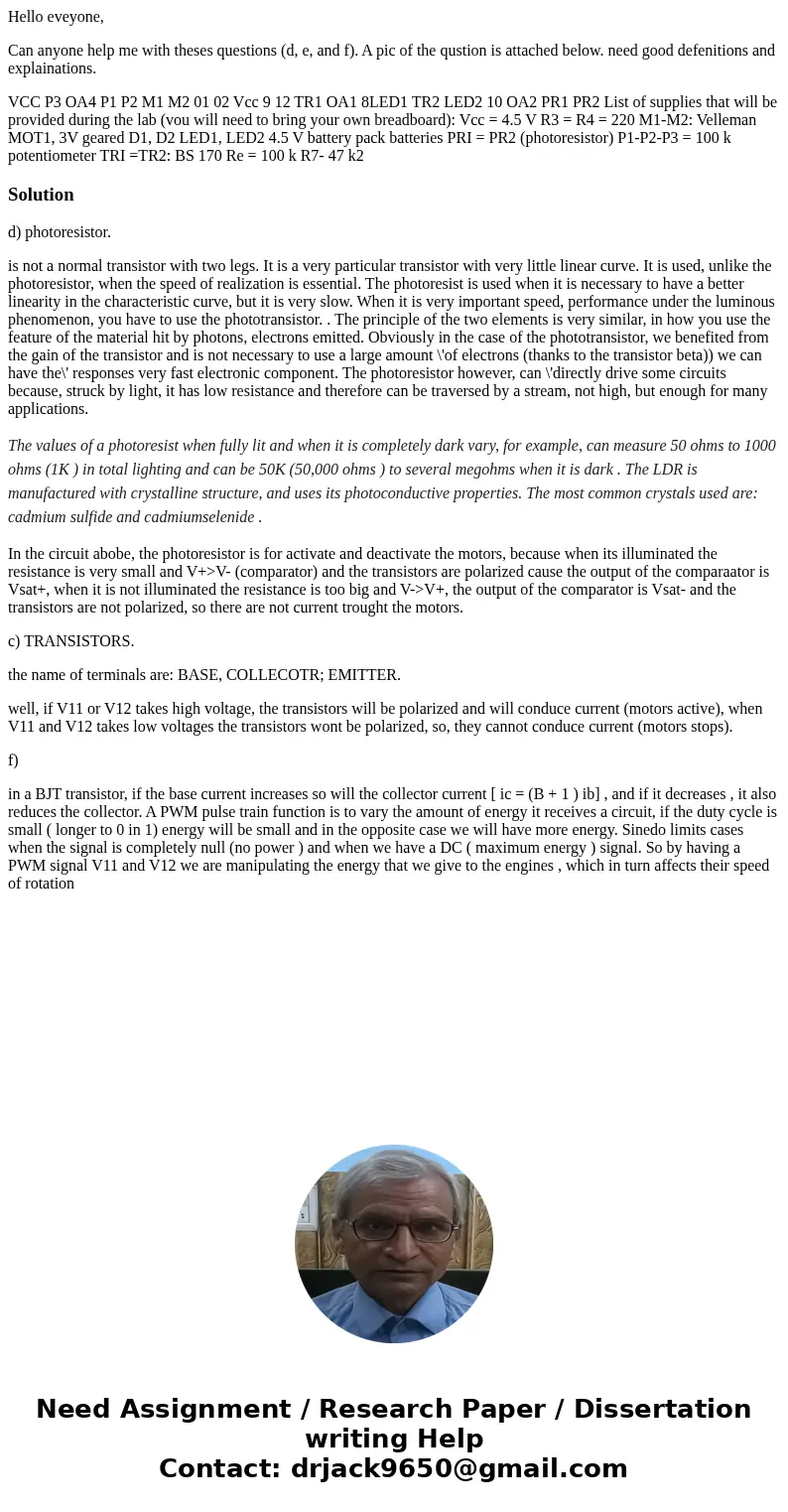Hello eveyone Can anyone help me with theses questions d e a
Hello eveyone,
Can anyone help me with theses questions (d, e, and f). A pic of the qustion is attached below. need good defenitions and explainations.
VCC P3 OA4 P1 P2 M1 M2 01 02 Vcc 9 12 TR1 OA1 8LED1 TR2 LED2 10 OA2 PR1 PR2 List of supplies that will be provided during the lab (vou will need to bring your own breadboard): Vcc = 4.5 V R3 = R4 = 220 M1-M2: Velleman MOT1, 3V geared D1, D2 LED1, LED2 4.5 V battery pack batteries PRI = PR2 (photoresistor) P1-P2-P3 = 100 k potentiometer TRI =TR2: BS 170 Re = 100 k R7- 47 k2Solution
d) photoresistor.
is not a normal transistor with two legs. It is a very particular transistor with very little linear curve. It is used, unlike the photoresistor, when the speed of realization is essential. The photoresist is used when it is necessary to have a better linearity in the characteristic curve, but it is very slow. When it is very important speed, performance under the luminous phenomenon, you have to use the phototransistor. . The principle of the two elements is very similar, in how you use the feature of the material hit by photons, electrons emitted. Obviously in the case of the phototransistor, we benefited from the gain of the transistor and is not necessary to use a large amount \'of electrons (thanks to the transistor beta)) we can have the\' responses very fast electronic component. The photoresistor however, can \'directly drive some circuits because, struck by light, it has low resistance and therefore can be traversed by a stream, not high, but enough for many applications.
The values of a photoresist when fully lit and when it is completely dark vary, for example, can measure 50 ohms to 1000 ohms (1K ) in total lighting and can be 50K (50,000 ohms ) to several megohms when it is dark . The LDR is manufactured with crystalline structure, and uses its photoconductive properties. The most common crystals used are: cadmium sulfide and cadmiumselenide .
In the circuit abobe, the photoresistor is for activate and deactivate the motors, because when its illuminated the resistance is very small and V+>V- (comparator) and the transistors are polarized cause the output of the comparaator is Vsat+, when it is not illuminated the resistance is too big and V->V+, the output of the comparator is Vsat- and the transistors are not polarized, so there are not current trought the motors.
c) TRANSISTORS.
the name of terminals are: BASE, COLLECOTR; EMITTER.
well, if V11 or V12 takes high voltage, the transistors will be polarized and will conduce current (motors active), when V11 and V12 takes low voltages the transistors wont be polarized, so, they cannot conduce current (motors stops).
f)
in a BJT transistor, if the base current increases so will the collector current [ ic = (B + 1 ) ib] , and if it decreases , it also reduces the collector. A PWM pulse train function is to vary the amount of energy it receives a circuit, if the duty cycle is small ( longer to 0 in 1) energy will be small and in the opposite case we will have more energy. Sinedo limits cases when the signal is completely null (no power ) and when we have a DC ( maximum energy ) signal. So by having a PWM signal V11 and V12 we are manipulating the energy that we give to the engines , which in turn affects their speed of rotation

 Homework Sourse
Homework Sourse